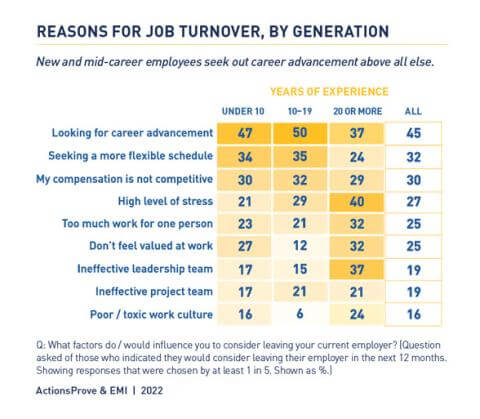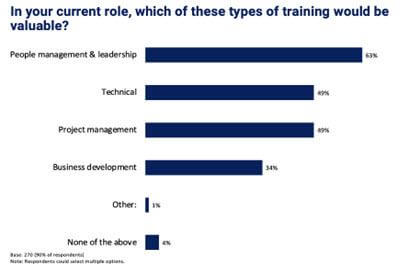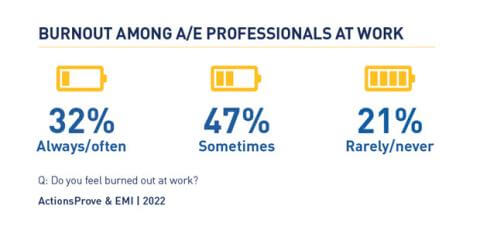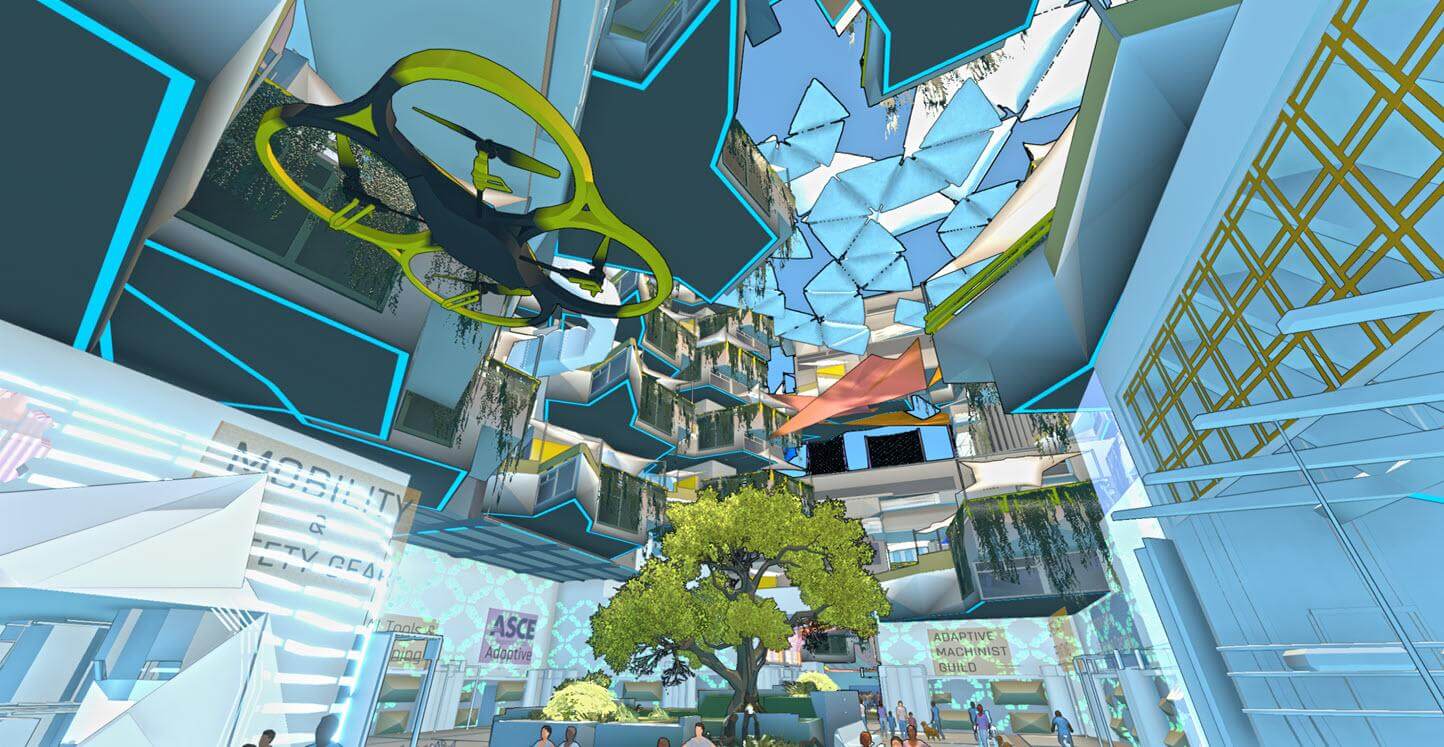
Explore
See how Future World Vision comes to life through an immersive VR experience.
The civil engineering industry has been very strong in recent history; however, this boom has come with several challenges, the biggest one being hiring (and retaining) talented professionals.
The Engineering Management Institute teamed up with ActionsProve to try to understand how A/E firms can overcome these challenges.
In this article, I would like to share excerpts from the culmination of our findings, a report titled the “Present and Future of Work in Engineering and Architecture in 2022.” The report is an in-depth study of the state of the industry and talent market and provides strategies that A/E firms can use to compete in this fast-changing world. These directives are detailed at the end of this article, but first …
Our research shows turnover for engineering and architecture talent is still at record highs. Hiring engineers and architects has been challenging for at least a decade, but post-pandemic growth fueled by strong public- and private-sector spending and the post-COVID “snapback” is exacerbating talent market pressures.
EMI and ActionsProve surveyed hundreds of A/E professionals and 80% of the group expected growth in 2022 – with nearly 40% predicting strong growth – despite rising inflationary pressures and ongoing supply chain slowdowns.

In a recent poll at the Environmental Financial Consulting Group’s CEO conference, 90% of attendees cited the “war for talent” as the No. 1 trend affecting employer decision-making. The research shows the Great Resignation in the A/E sector shows no signs of abating.
● Nearly two out of three (61%) attendees say they would consider leaving their current employer in the next 12 months for the right opportunity. And 26% would strongly consider leaving.
● Turnover risk is higher among younger professionals. 83% of those with less than five years’ experience would consider leaving their current employer – and of that group, 40% would strongly consider resigning.
● The share of professionals who are unlikely to leave may, in fact, be closer to 10%. Even among those who say they’re not considering resigning, three in four say they would consider it under certain circumstances – most often for substantially higher pay (40%) and/or quality-of-life improvements (32%).
In other words, even those employees you think are unlikely to resign – whether due to longevity or some other factor – are not truly “safe.”
The biggest reason by a large margin is the search for career advancement opportunities (45% cite this). Across industries, the Great Resignation offers employees the chance to leapfrog to more attractive positions and advance their careers – and large numbers are seizing the opportunity.
Compensation, while important, ranks 15 points lower than the search for advancement opportunities.
“Many assume that increasing salary offers or bonuses will on its own retain top talent, but the research shows money isn’t the primary reason A/E talent seeks out new jobs,” said Peter C. Atherton, president and founder of ActionsProve. “Engineers and architects are in search of career development opportunities, as well as greater flexibility about the ‘where’ and ‘when’ of work – and companies that resist change in these areas will find themselves struggling to hire and retain top candidates.”
Younger people are in search of career advancement opportunities and a more flexible schedule when they leave their employer, whereas more experienced professionals are most likely to cite stress as the key driver. They might also feel overworked and unappreciated.

To overcome the challenges of the Great Resignation, A/E employers, including civil engineering firms, must leverage data to create a futureproof, dynamic, human-centered workplace.
The research shows there is still significant work to be done to define new workplace norms and ensure those new norms power high performance for the organization.
1. Understand the “Great Resignation” is far from over.
Instead, consider this an opportunity for a “Great Reset and Redesign.” With demand for top talent continuing unabated, it’s time to reimagine recruitment and retention practices, and revisit the way work gets done.
Among all professionals we surveyed, just 25% “strongly agree” that they see a path for career advancement at their company. Given that career advancement (or lack thereof) is the No. 1 reason people switch employers, this finding should be troubling for many employers.
Now may also be a time to refine or even redesign project management practices and workflows. For example, adopting more lean and agile processes, leveraging new technologies to empower distributed teams, and reskilling managers to oversee hybrid teams. All of this is in service of more effective, efficient teams.
2. Commit to training and development as a strategic asset.
Provide more support with essential “people skills” for engineers and architects. Our research shows that two in three employees would find people management and leadership useful – that’s 14 points higher than technical skills. For companies using a hybrid or virtual work model, this type of training is essential – not only to oversee a short-term pivot to virtual working, but to fuel long-term digital transformation, adjust to marketplace disruptions, and meet the growing complexity of client demands.

3. Use a people-centric, data-driven approach to surface hotspots.
Diagnose workplace issues by engaging employees at regular intervals about their specific challenges at work, areas of dissatisfaction, and areas for growth. Use this data to address individual employees, but also consider aggregating the data to pull out important trends. For example, how are women faring in management roles? Is dissatisfaction higher on specific teams? Also, use stay and exit interviews to aggregate and discover the common variables driving both retention and turnover.
4. Consider quality of life as a critical benefit in the employee relationship.
Top engineering and architecture talent don’t want to settle for the traditional work trade-off: higher pay and career advancement in exchange for long hours and high degrees of stress. High rates of turnover are fueling a radical shift in workplace expectations. A/E talent today, especially the most sought-after talent, are not willing to sacrifice family life and hobbies to earn promotions or make partner. Employers who want to attract and retain the very best should similarly banish the either/or mindset – and help older, more stressed colleagues to do the same.
Our study shows 32% of engineers and architects are “always or often” burned out from their work – a startling finding. The pandemic has given people the chance to look critically at stress, burnout, and quality of life – and choose to work differently.

5. Revisit the company’s mission and vision.
Our research shows that people-first companies are more likely to have a documented mission/vision statement.
Employees at those companies are also much more likely to feel engaged with that mission. Consider how your company can not only create a desirable work environment but create a higher sense of meaning and purpose at work. "We’re witnessing a radical shift in career expectations: people want to win at both work and life – and do so while making a difference and having impact,” Atherton said. “This has fundamentally changed how we need to lead and develop our teams and organizations.”
6. Strengthen hiring practices for more part-time and freelance professionals.
The research shows nearly half (46%) of engineers and architects are either actively pursuing or highly interested in an independent/freelance career, up 28 points since last year. Sourcing and deploying freelancers will soon be mission-critical for companies in the A/E sector. Find ways to leverage part-time and independent professionals more effectively by developing more robust sourcing methods, investing in technology to boost collaboration between employees and freelancers, and even exploring why your company may be resistant to tapping this valuable asset.
There are also professionals who have left or plan to leave full-time traditional employment. Finding ways to welcome and integrate these professionals back in a part-time capacity will be an advantage.
7. Design a future of work that is above all flexible.
We are witnessing a historic resetting of the employer-employee relationship, and our research shows that flexibility may be more important than any one tactic in 2022 and beyond. That means
● Reshaping how and where work gets done and giving employees more agency to find the right formula.
● Rethinking the role work plays in an employee’s life, and supporting quality-of-life improvements, whether in-office or outside the office.
● Redefining workplace culture for engineers and architects – pushing back on long hours, high stress, in-person-only salaried employment.
"Organizations will lose talent if they don't adapt to candidate and employee expectations around these issues," said Amber Ferrari, marketing manager at Jobvite. "Some form of flexibility is becoming less of a perk and more of a real expectation."
Ultimately, the goal is success from anywhere (SFA): a methodology to empower people no matter where or how they work. It should not matter whether someone is in-office or virtual, full-time or part-time, employed or independent. What does matter is that the conditions are in place for teams to produce excellent results.
We believe this ethos – not just tolerating but empowering more flexible teams – will allow for more sustained growth and prosperity and help fuel a new generation of innovation in the industry.
Anthony Fasano, P.E., F.ASCE, left his engineering career behind to focus on inspiring the next generation of engineering leaders. Since he made that shift in 2009, he has become a globally recognized TEDx speaker, host of three engineering podcasts that have been downloaded over 3 million times, and author of the bestselling book for engineers, "Engineer Your Own Success: 7 Key Elements to Creating an Extraordinary Engineering Career."
Download a copy of the "Present and Future of Work in Engineering and Architecture in 2022" report.
Subscribe to the quarterly Future World Vision newsletter to stay up to date with news and events.

See how Future World Vision comes to life through an immersive VR experience.

Stay updated on the upcoming Future World Vision giant-screen film, Cities of the Future.

Create and share your own custom tour of Mega City 2070.